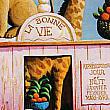Twentieth Century Artists of Grand Rapids
In 1901 a local artist, Fred de Forrest Schock, gave a public lecture on his book illustrations, revealing that his models were local persons.
In 1902 the Evening Press revealed that a painting by Gilbert White, brother of author Stewart Edward and Roderick, had been accepted for exhibition in Paris. Famous both as a raconteur and painter, Gilbert spent most of his adult years in Paris and died there in 1939 at the age of 62.
Numerous Grand Rapids painters were attracting international attention in the first decade of the twentieth century. There were Miss Eulabee Dix, highly esteemed for her miniatures, and Larry C. Earle, who attracted wide attention for his murals in the Chicago National Bank.
William S. Horton was another Grand Rapids artist whose work was exhibited in Paris. Frederick S. Church is remembered for his etchings. In the 1920’s Alexander Flyn was heralded for his portraits. In 1923 a Chicago art connoisseur, J.W. Young, predicted great futures for a pair of Grand Rapids artists, Will Howe Foote and Gregory Smith. Glenn Newell, a Grand Rapids native, won renown for his animal and landscape paintings.
Of the early Grand Rapids painters easily the most prolific, versatile, and most famous was Mathias Alten. Art critics were hailing him as a leading American painter as early as 1903. Although he was strictly a representational painter, he was honored by artists of all schools. His death in 1938 was noted in art journals and newspapers all over the country.
Contemporary with Alten was Gerrit A. Beneker, who first gained fame as an illustrator. A Central High School graduate, Beneker vowed to win recognition as a painter, and by 1915 he was much sought after by leading art galleries around the country.
Kreigh Collins, one of Grand Rapids’ most active artists in 1966, came to attention as early as 1926, with an exhibit of his landscapes in Ryerson Library. Collins was recognized widely for his book illustrations, the first of which were prepared for a volume of Mark Twain’s stories and a volume on Buffalo Bill. But it was as the creator of a historical strip that ran in the Sunday newspapers and was titled Kevin the Bold that Collins was best known.
At mid-century and later one of Grand Rapids’ most successful artists was Orville Bulman. He attended art school briefly but couldn’t wait and moved out on his own. He started painting conventional scenes and people, but a series of trips to Haiti persuaded him to invent a whole mystical island, people it with a wonderful population of happy, ingenious folk and some of the most remarkable animals since Rousseau. There were smiling lions and jaunty roosters and numerous other mirth-provoking members of Bulman’s menagerie. And there were always the slim, highly festooned, ornamented houses that were caricatures of dwellings he had seen in Haiti.
Sometime he painted old houses of baroque design, but most of his paintings, numbering several hundred, chronicled the wondrous happenings on Bulman Island. His one-man shows, whether in Paris, New York, Palm Beach, or Beverly Hills, were sold out before the doors officially opened. The Duke and Duchess of Windsor had several of his paintings.
In 1936 a brief new item noted that Reynold H. Weidenaar, age 20, had displayed a water color of “Blind Ed,” a familiar local figure. Three years later Weidenaar received the Vanderslice scholarship to attend the Kansas City Art Institute for a year. In 1941 Weidenaar’s etching titled Evening Storm was selected for the permanent collection of the Library of Congress.
The year after Weidenaar loomed on the horizon another fine art star rose in Grand Rapids. Armand Merizon of Davis Vocational and Technical High School received a $500 scholarship to attend George Vesper Art School in Boston. In the beginning he devoted his attention largely to seascapes. And though for the next 30 years he continued to return to the sea and to other waterways, including Michigan rivers, for his inspiration and subject matter, Merizon painted the whole panorama of nature and of man’s doings.
Another Grand Rapids-born artist who won fame in more than one field was Dirk Gringhuis, author and illustrator of a score of books on various aspects of Michigan as well as illustrator of many books by other authors. Basically a painter, Gringhuis was entrusted with one of the most important historical assignments in the state, the painting of 15 murals at Fort Mackinac on Mackinac Island and Fort Michilimackinac at Mackinaw City. An avid student of the Indian fur trader era in Michigan history, Gringhuis assisted in the restoration of both of the forts.
Excerpted from The Story of Grand Rapids, pages 438-441, by Z.Z. Lydens, editor

 facebook
facebook
